GK Physiotherapy Centre has been providing comprehensive services in the treatment, prevention and consultation of the following:.
Buttock/thigh Conditions:
1Quadriceps Muscle Strains 2) Quadriceps Tendon Rupture 3) Groin Strain (Adductor Strain) 4)Trochanteric Bursitis 5) Hamstring Strains 6) Femoral Neck Fracture 7) Hip Osteoarthritis.
Quadriceps Muscle Strains: Treatment
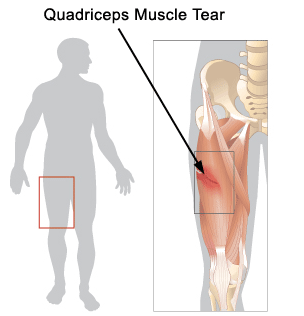 This injury is commonly the result of quick sprints or quick stops while running. With a muscle strain, there is localized tenderness or a bulge in the tender area of the thigh. The pain is aggravated by lifting the thigh (a straight leg raise), ascending/descending stairs, or getting up from a seated position
This injury is commonly the result of quick sprints or quick stops while running. With a muscle strain, there is localized tenderness or a bulge in the tender area of the thigh. The pain is aggravated by lifting the thigh (a straight leg raise), ascending/descending stairs, or getting up from a seated position
Quadriceps Tendon Rupture:
Treatment
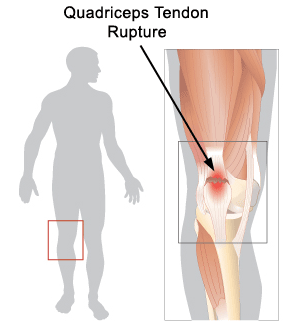 This injury is often the result of forceful kicking or a traumatic impact to the tendon, which may occur with a fall. Signs and symptoms include pain and bruising just above the kneecap, an inability to walk, and severe weakness of the quadriceps (making it impossible to ascend/descend stairs). Surgical repair is necessary.
This injury is commonly the result of quick sprints or quick stops while running. With a muscle strain, there is localized tenderness or a bulge in the tender area of the thigh. The pain is aggravated by lifting the thigh (a straight leg raise), ascending/descending stairs, or getting up from a seated position
This injury is often the result of forceful kicking or a traumatic impact to the tendon, which may occur with a fall. Signs and symptoms include pain and bruising just above the kneecap, an inability to walk, and severe weakness of the quadriceps (making it impossible to ascend/descend stairs). Surgical repair is necessary.
This injury is commonly the result of quick sprints or quick stops while running. With a muscle strain, there is localized tenderness or a bulge in the tender area of the thigh. The pain is aggravated by lifting the thigh (a straight leg raise), ascending/descending stairs, or getting up from a seated position
Groin Strain (Adductor Strain): Treatment
 This injury usually occurs in sports where cutting, side-stepping, or pivoting are required. Often, there is forceful separation of the legs or twisting of the toe outward. Signs and symptoms include pain and tenderness in the inner thigh region.
This injury is commonly the result of quick sprints or quick stops while running. With a muscle strain, there is localized tenderness or a bulge in the tender area of the thigh. The pain is aggravated by lifting the thigh (a straight leg raise), ascending/descending stairs, or getting up from a seated position.
This injury usually occurs in sports where cutting, side-stepping, or pivoting are required. Often, there is forceful separation of the legs or twisting of the toe outward. Signs and symptoms include pain and tenderness in the inner thigh region.
This injury is commonly the result of quick sprints or quick stops while running. With a muscle strain, there is localized tenderness or a bulge in the tender area of the thigh. The pain is aggravated by lifting the thigh (a straight leg raise), ascending/descending stairs, or getting up from a seated position.
Trochanteric Bursitis Treatment
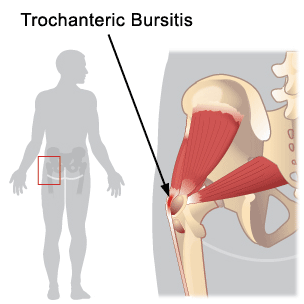 A bursa is a fluid-filled sack that decreases shear forces between tissues of the body. Trochanteric bursitis (inflammation of a bursa) is caused by excessive stress on the bursa between the IT Band and the greater trochanter. Signs and symptoms include pain over the outer aspect of the hipbone, which often is exacerbated when lying on the affected side, standing on the affected leg, or excessive walking. Treatment often includes rest, ice, and compression, physical therapy including stretching and progressive strengthening.
A bursa is a fluid-filled sack that decreases shear forces between tissues of the body. Trochanteric bursitis (inflammation of a bursa) is caused by excessive stress on the bursa between the IT Band and the greater trochanter. Signs and symptoms include pain over the outer aspect of the hipbone, which often is exacerbated when lying on the affected side, standing on the affected leg, or excessive walking. Treatment often includes rest, ice, and compression, physical therapy including stretching and progressive strengthening.
Hamstring Strains:: Treatment
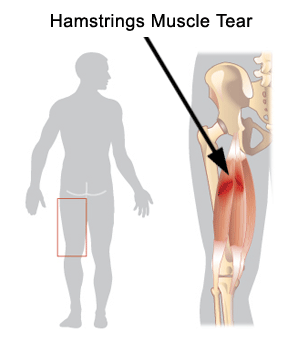 A strain is a minor tear of a muscle. Quick acceleration while running or cutting is most often the cause of hamstrings strains. A minor pulling or a pop may be noted in the back of the thigh. Pain, swelling, and an inability to run result. Treatment includes rest, ice, compression, elevation, and physical therapy.
This injury is commonly the result of quick sprints or quick stops while running. With a muscle strain, there is localized tenderness or a bulge in the tender area of the thigh. The pain is aggravated by lifting the thigh (a straight leg raise), ascending/descending stairs, or getting up from a seated position.
A strain is a minor tear of a muscle. Quick acceleration while running or cutting is most often the cause of hamstrings strains. A minor pulling or a pop may be noted in the back of the thigh. Pain, swelling, and an inability to run result. Treatment includes rest, ice, compression, elevation, and physical therapy.
This injury is commonly the result of quick sprints or quick stops while running. With a muscle strain, there is localized tenderness or a bulge in the tender area of the thigh. The pain is aggravated by lifting the thigh (a straight leg raise), ascending/descending stairs, or getting up from a seated position.
Femoral Neck Fracture Treatment
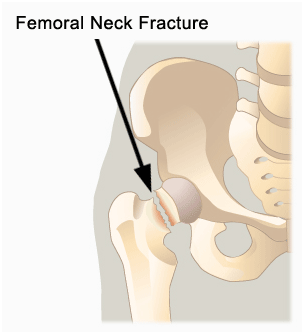 A bad fall or blow to the hip can break (fracture) the thigh bone typically around the femoral neck region. If the broken bone does not heal properly, the joint may slowly wear down. Blood flow through the femoral head may be restricted or cut off leading to the necrosis of the joint.
This injury is commonly the result of quick sprints or quick stops while running. With a muscle strain, there is localized tenderness or a bulge in the tender area of the thigh. The pain is aggravated by lifting the thigh (a straight leg raise), ascending/descending stairs, or getting up from a seated position.
A bad fall or blow to the hip can break (fracture) the thigh bone typically around the femoral neck region. If the broken bone does not heal properly, the joint may slowly wear down. Blood flow through the femoral head may be restricted or cut off leading to the necrosis of the joint.
This injury is commonly the result of quick sprints or quick stops while running. With a muscle strain, there is localized tenderness or a bulge in the tender area of the thigh. The pain is aggravated by lifting the thigh (a straight leg raise), ascending/descending stairs, or getting up from a seated position.
Hip Osteoarthritis: Treatment
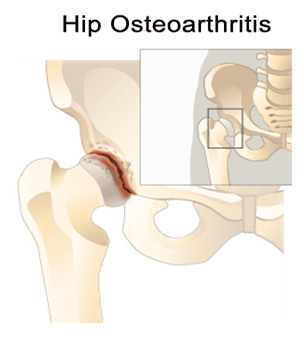 Osteoarthritis of the hip occurs when the cartilage coverings on ball (the head of the femur) and the socket (the acetabulum) wear out. It is worse when you bear weight on the affected limb. Range of motion is often limited especially internal rotation and hip flexion. Recent studies have demonstrated that joint mobilization and stretching can result in significant pain relief.This injury is commonly the result of quick sprints or quick stops while running. With a muscle strain, there is localized tenderness or a bulge in the tender area of the thigh. The pain is aggravated by lifting the thigh (a straight leg raise), ascending/descending stairs, or getting up from a seated position.
Osteoarthritis of the hip occurs when the cartilage coverings on ball (the head of the femur) and the socket (the acetabulum) wear out. It is worse when you bear weight on the affected limb. Range of motion is often limited especially internal rotation and hip flexion. Recent studies have demonstrated that joint mobilization and stretching can result in significant pain relief.This injury is commonly the result of quick sprints or quick stops while running. With a muscle strain, there is localized tenderness or a bulge in the tender area of the thigh. The pain is aggravated by lifting the thigh (a straight leg raise), ascending/descending stairs, or getting up from a seated position.
Copyright © 2013 GK Physiotherapy Clinic | Bangalore
